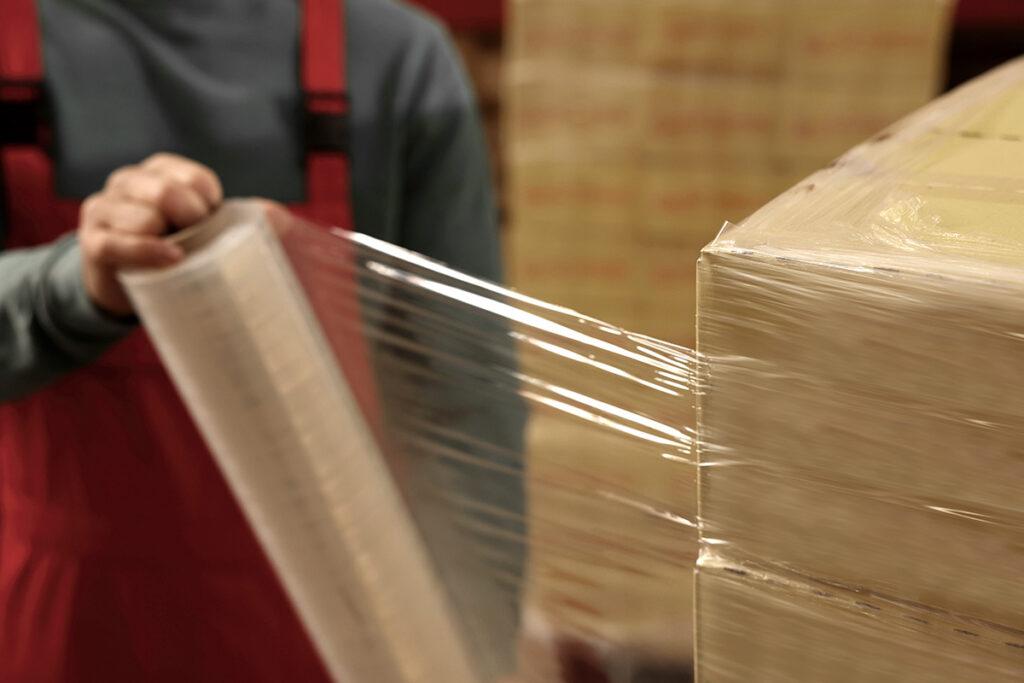Warehouses across the U.S. use pallet wrap and stretch film to secure goods in place, preparing them for transportation or storage. The wrap is ideal for bundling units and prevents tearing by sticking to the products instead of to each other.
However, pallet wrap is capable of breaking, mainly when incorrectly applied. The type and quality of the pallet wrap can also affect its durability, potentially requiring additional wrapping and driving up packaging costs. Here are six tips to avoid breakage.
1. Understand why pallet wrap breaks
There are two main reasons for breakage: There’s something wrong with the film, or the operator or machine misapplies it.
Film comes in all shapes and sizes; if the wrong one is applied, your pallets may be at risk from the start. The gauge of the film, its containment force, the production method used to create it, and even your supplier are all factors that can affect the suitability of the film.
Incorrect application is usually caused by one factor: human error. When the stretch film is wrapped around the pallet by hand instead of by a machine, there is more room for minor mistakes. Careless rips in the stretch film can occur, especially if users rush to fulfill an order. Packers may also be applying the wrong side of the film, leaving the sticky side facing outwards. In these cases, stretch film will stick to other wrapped packages, causing tears when objects shift during transport.
2. Know the basics of pallet wrapping
Critical to effective storage and transportation is ensuring the pallet is secured correctly. To make a pallet load less likely to shift and cause pallet wrap breakage, operators should:
- Understand tension: How much force is being applied to a pallet load by the wrap at any given time is its tension, measured in pounds. Light loads may only require a few pounds of force, while heavy loads could require over 20 pounds of force. Operators can use devices such as a pull test kit to ensure the wrap applies adequate tension and that the containment force is equal across the entire load.
- Pre-stretch film: Warehouses often use pre-stretched wrap. With this type of film, the elasticity helps secure the pallet as the film attempts to shrink back to its original state, causing constant tension.
- Optimize the wrapping technique: Film should be applied with the sticky side facing inwards and overlap to ensure stability. A machine can help automate both these tasks and reduce human error, but operators and managers should seek expert guidance on the machine’s ideal settings for the film used.

Learn more about the Sanstrap re
3. Use the right film for the right job
There are different film production methods, the main two are blown or cast film. They have different strengths, weaknesses, and applications.
- Blown film is highly durable and hard to tear, even with sharp objects. This durability makes it ideal for transporting or storing goods that have pointed edges. A large portion of conventional hand film is blown stretch film—the elongation properties of blown hand film work well for heavy loads and less uniform pallets.
- Cast film continues to make advances in the extrusion process and its capabilities. Cast film production produces a more consistent film thickness with higher clarity than blown film. Cast film has a more cost-effective manufacturing process and is more technologically advanced than blown film. This process allows for a wider variety of films to be produced resulting in the ability to utilize a thinner gauge film to achieve the same performance results.
Choosing between the two types of film depends on the application and if the film application is by hand or machine. A colder environment or a less uniform pallet lends well to blown hand film, whereas higher volume hand and machine applications are better suited for cast films. If cost is a factor, cast films are a better choice as a wider variety of high-performance options are available at an affordable price.
4. Defend against the elements
Visible breakage isn’t the only cause of pallet wrap failure. Pallets stored outside or likely to be exposed to the elements during transportation will need protection from UV light and temperature changes.
If stretch wrap can’t withstand extreme temperatures, it may shrink, break, or lose its cling. Using film designed to withstand a specific temperature range is crucial.
5. Train employees
The easiest way to reduce pallet wrap breakage is to educate warehouse operators on how best to handle and apply the film.
Operators should consult with experts and be trained to understand which type of film they should use, how thin it can be, whether it has the proper tension, and when to use pre-stretched film.
Workers also need to be trained on the optimal ways to wrap products and how to operate automatic machines to reduce waste even further. The correct machine settings can minimize usage and prevent damage to both the pallet wrap and transported goods.
Read more:
Warehouse supplies and customer service go hand in hand
6. Communicate the costs
Pallet wrap breakage is more than a mere annoyance. Beyond the obvious need for additional wrapping materials, it can result in:
- Delays in transportation: Frequent mishandling of pallet wrap will cause delays that significantly slow shipping and receiving.
- Damaged or lost goods: Breakages missed during application mean that products could shift, fall, or even become lost mid-transport.
Understanding and communicating these costs to warehouse managers can help ensure the right research is being done to supply warehouses with appropriate pallet wrap that meets the needs of an order.
Efficiency is king
Ultimately, film breakage is a loss for any warehouse. It costs time, money, and resources, which causes frustration among employees who deliver more than a trillion packages annually in the United States.
Any steps that warehouse operators can take to reduce this loss will improve the overall efficiency of the warehouse. Training, research, and investment in expert advice can all reduce costs and protect products, resulting in significant advantages in the long run.
Need to speak to an expert in pallet wrap? Contact a distributor, call us at 216-486-9400, or learn more about the types of film we offer here.

